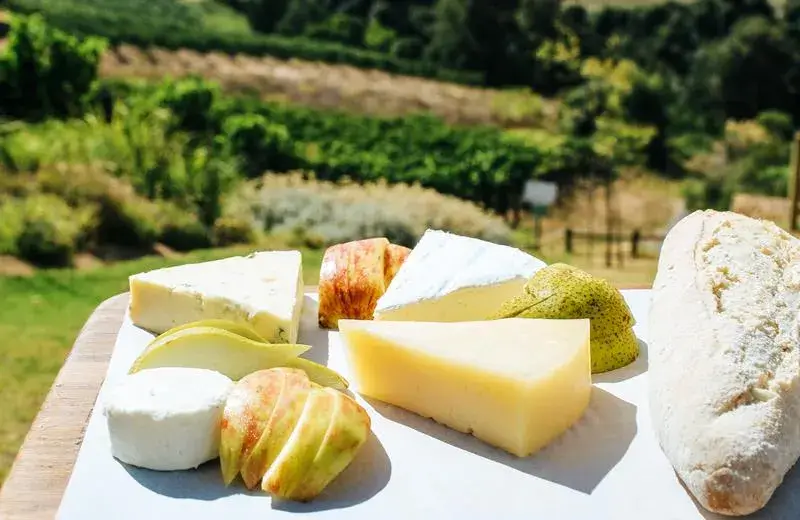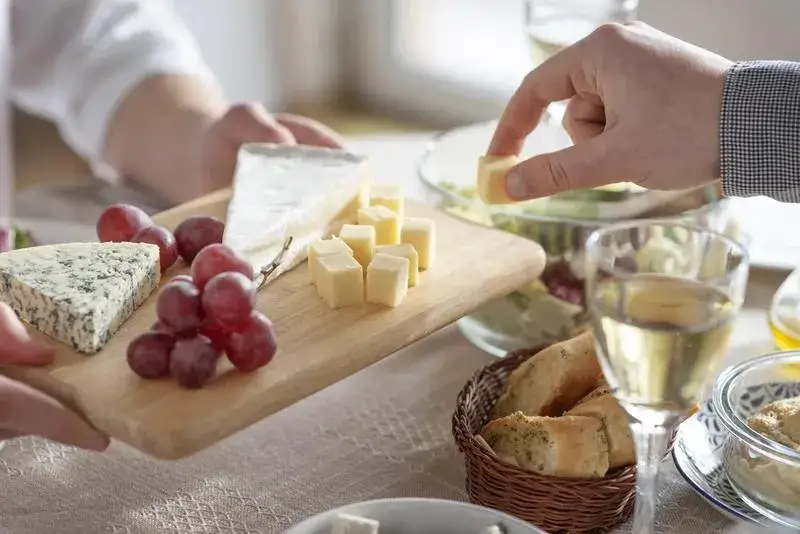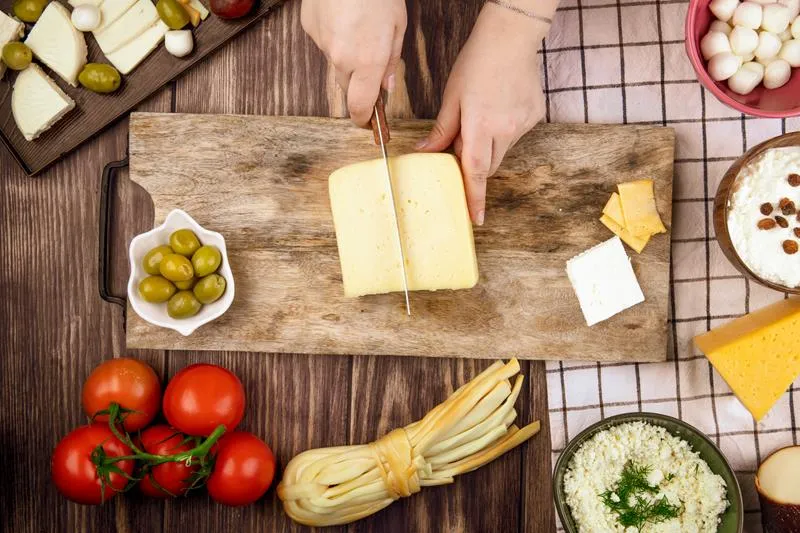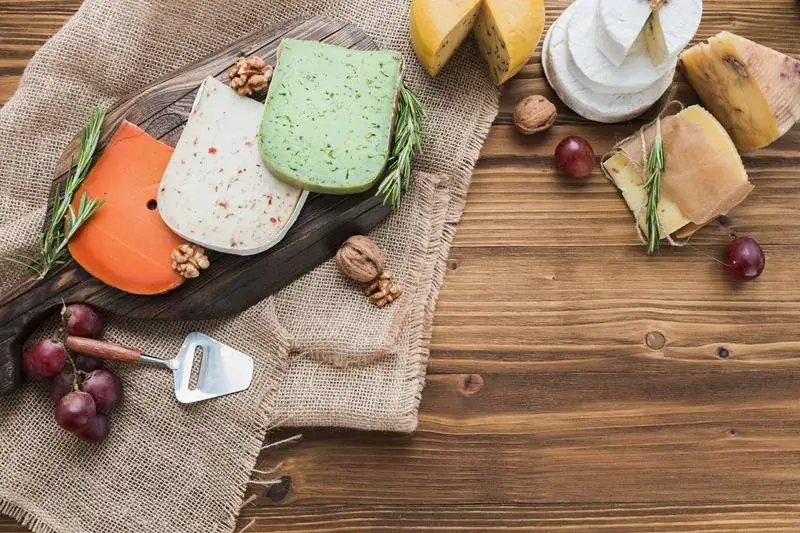Cheese is one of the world’s oldest food treasures. Born over 8,000 years ago from a fortunate milk accident, cheese has evolved into over 2,500 irresistible varieties worldwide, ranging from bold and aged to creamy and mild. Ready to discover the legends behind your favorite slices? Let’s unwrap the magic of cheese.
Mozzarella — fresh, simple, and purely Italian
Named from the Italian “mozzare” (“to cut”), it has been made from buffalo milk in southern Italy since the 12th century. In the late 1700s, the French Bourbon royals helped spread their delicate, fresh flavor across Europe.
This cheese is more than just tasty, it’s packed with essential nutrients that benefit your health:
- High in protein: supports muscle growth and repair.
- Biotin strengthens nails and hair, and helps lower blood sugar in diabetics.
- Vitamins B aid in migraine relief and boost metabolism.
- Calcium and phosphorus enhance bone and dental strength.
- Supports healthy heart function with magnesium and potassium.
Bring a taste of Italy right into your kitchen with these two simple recipes:
- Classic Mozzarella Pizza: Spread a thin layer of tomato sauce over your dough, top with fresh mozzarella slices and fragrant basil. Bake at 200°C for about 15 minutes until the crust is perfectly golden and bubbly.
- Caprese Salad: Layer juicy tomato and mozzarella slices on a plate, sprinkle with fresh basil, then drizzle with olive oil and a splash of balsamic vinegar for that perfect tang.
Mozzarella goes best with light white (Pinot Grigio, Sauvignon Blanc), dry rosé or sparkling wines like Prosecco and Cava, which will highlight its delicate taste.
Parmesan: the king of hard cheeses
This legendary Italian cheese hails from the city of Parma and has been loved since the 12th century. It matures for at least a year—often two or even three—developing a deep, rich flavor with delicious nutty hints.
Parmesan is a nutrient-dense cheese with key benefits:
- High in protein – 100 g of Parmesan equals 200 g of beef.
- Rich in calcium and phosphorus – supports strong bones and teeth.
- Virtually lactose-free – long aging makes it suitable for most with lactose intolerance.
- High in salt – 100 g has about half the daily limit.
But a quick heads-up: if you have high blood pressure, diabetes, kidney issues, or any condition tied to your body’s water-salt balance, it’s best to enjoy Parmesan in moderation.
Savor simple dishes starring the king of cheeses:
- Parmesan Pasta: Cook spaghetti or penne until just al dente, toss with a bit of olive oil or butter, then finish with a generous sprinkle of grated Parmesan.
- Grilled Veggie Salad: Roast zucchini and eggplant, top with grated Parmesan, and serve it warm for a cozy treat.
Parmesan pairs perfectly with rich whites (Chardonnay), aged reds (Chianti, Barolo) or dessert wines like Porto, which highlight its rich, nutty, salty flavor.

Brie: where French tenderness meets flavor
This delicate cheese appeared in France during the time of Charlemagne. This soft product with a noble white mold is famous for its creamy texture and delicate mushroom aroma. It ripens for about a month and has a rich taste.
Brie cheese provides significant vitamins and minerals that contribute to your health:
- Vision, skin health, and energy metabolism are improved by vitamins A, E, and B12;
- Zinc and selenium support a healthy immune system;
- The white mold on brie helps with digestion by promoting the production of B vitamins.
For blue cheese, the recommended adult portion is up to 70 grams. Consuming more than this may cause digestive discomfort due to its richness.
Experience French elegance with these simple Brie recipes:
- Brie on Toast: Pop a creamy slice of Brie on crispy toast, then add a drizzle of honey or a spoonful of berry jam for that perfect sweet and creamy combo.
- Brie Salad: Layer fresh lettuce, sliced apples, and chunks of Brie on a plate, sprinkle with crunchy walnuts, and finish with a drizzle of olive oil, lemon juice, and honey.
Brie goes best with champagne or soft whites (Chardonnay, Sauvignon Blanc), which harmoniously highlight its creamy texture and delicate taste.
Aged Cheddar — the classic taste of England
Cheddar was born in the village of Cheddar, Somerset, back in the 12th century. Its bold, rich flavor comes from aging that lasts months—or even years. With about 390 kcal per 100 g, it’s a tasty and energy-packed choice.
Cheddar is delicious food that gives your body nutrients that it will love:
- Vitamins A, E and B2 help your eyes, skin and energy levels;
- Calcium and phosphorus help build bones and teeth;
- Copper and iron assist blood health and help combat tiredness.
- Recommended during early pregnancy: Helps maintain healthy hair and teeth.
- Supports heart and digestive health: Thanks to its mix of micro- and macroelements.
Cheddar isn’t for everyone—avoid if you have digestion issues, excess weight, or lactose intolerance. Kids under 3 should skip it; for those under 10, limit intake to protect the pancreas.
Enjoy a bite of English charm with these easy cheddar recipes:
- Cheddar Burger: Top a hot beef patty with a slice of aged cheddar, add fresh lettuce and tomatoes, and tuck it all into a soft bun for a burst of rich, savory flavor.
- Cheesy Baked Veggies: Roast zucchini or broccoli with shredded cheddar until bubbly and golden—comfort food at its finest.
Pairs perfectly with bold reds like Cabernet or Merlot, plus semi-sweet whites and sparkling wines that balance its rich tang.

Feta — Greece’s delicate cheese treasure
Feta is known for its distinctively crumbly texture and its tangy, salty goodness. It is a staple in Greek cuisine and is produced from sheep or goat’s milk. It is stored in brine, which gives it a unique flavor and also keeps it fresh. Feta doesn’t spoil and provides a wonderful addition to any dish.
Feta cheese brings essential nutrients that boost your wellbeing:
- Calcium and phosphorus strengthen bones and teeth.
- Conjugated linoleic acid (CLA) supports healthy metabolism.
- Vitamins B2 and B12 aid energy production and brain function.
Because feta is more easily digested than cow’s milk cheeses, it is a good option for people with mild lactose sensitivity.
Enjoy the zest of Greek sunshine with these simple feta ideas:
- Feta & Tomato Salad: Combine juicy tomatoes, cucumbers, and red onions, crumble feta on top, then drizzle with olive oil and sprinkle oregano for a classic Greek vibe.
- Baked Feta: Roast a block of feta with cherry tomatoes, olives, and herbs—serve warm with crusty bread for a cozy, flavorful treat.
What cheese is kid-friendly?
Cheese is good for kids since it is nutritious. Cheese provides vitamins and minerals that are vital for kids. Soft cheeses like mozzarella, brie and curd are rich in calcium and protein and are easy to digest for kids. Mild hard cheeses like young cheddar and Gouda also provide calcium and protein, as well as vitamins and minerals.
Children struggling with excess weight can be provided with low-fat cheeses. Benefits:
- Calcium: Strengthens bones fortified with calcium.
- Proteins: Aid muscle growth.
- Vitamins A, D, and B12: Support the immune and nerve systems.
- Microelements: Enable key functions in metabolism.

Author

Alexandra Mukhina
Content writer on https://rythmoftheworld.com Experienced linguist and translator with a knack for crafting and refining diverse content. My goal is to produce engaging, informative texts that captivate readers. Passionate about reading, music, traveling, and exploring new avenues of personal growth.



